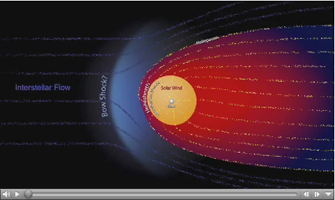
|
Streams of Charged Particles
- Click the image above for a larger view
- Full-Res JPEG (1280 x 720) (73.8 kB)
- Full-Res TIFF (1280 x 720) (2.8 MB)
Caption:

Figure 1
Click on the image for animation
This animated graphic shows the different streams of charged particles inside the bubble around our sun and outside, in the unexplored territory of interstellar space. In this schematic, our solar system is traveling to the left through the interstellar medium, molding our solar system into a comet-like shape.
Our sun, in the center of the yellow circle, gives off a stream of charged particles known as the solar wind. The solar wind travels at supersonic speeds until it hits a border region known as the heliosheath, where the solar wind slows down and heats up. The heliosheath, where NASA's two Voyager spacecraft are now traveling, is shown in red. The shockwave boundary between the two regions is known as the termination shock.
The pressure from the charged particles flowing between stars -- known as the interstellar flow -- forces the solar wind particles back down the tail of the comet-like shape. The boundary that separates an area dominated by interstellar charged particles rather than solar wind particles is known as the heliopause. The entire region from the heliopause inward is known as the heliosphere.
There may also be a shockwave known as the bow shock -- like the bow shock of a boat cutting through water -- in front of our heliosphere.
Background Info:
The Voyagers were built by NASA's Jet Propulsion Laboratory in Pasadena, Calif., which continues to operate both spacecraft. JPL is a division of the California Institute of Technology in Pasadena. The Voyager missions are a part of the NASA Heliophysics System Observatory, sponsored by the Heliophysics Division of the Science Mission Directorate.
For more information about the Voyager spacecraft, visit http://www.nasa.gov/voyager and http://voyager.jpl.nasa.gov .
Cataloging Keywords:
| Name | Value | Additional Values |
|---|---|---|
| Target | Heliosphere | |
| System | Solar System | |
| Target Type | Heliosphere | |
| Mission | Voyager | |
| Instrument Host | Voyager 1 | Voyager 2 |
| Host Type | Flyby Spacecraft | |
| Instrument | ||
| Detector | ||
| Extra Keywords | Color, Comet, Water | |
| Acquisition Date | ||
| Release Date | 2011-04-28 | |
| Date in Caption | ||
| Image Credit | NASA/JPL-Caltech | |
| Source | photojournal.jpl.nasa.gov/catalog/PIA13898 | |
| Identifier | PIA13898 | |
